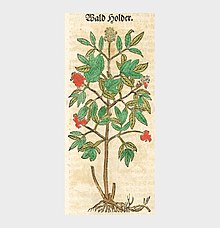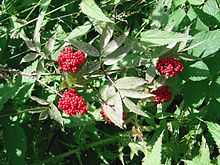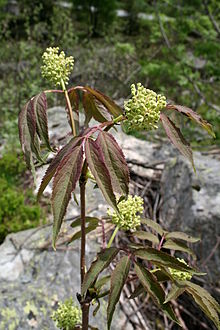Red elder
| Red elder | ||||||||||||
|---|---|---|---|---|---|---|---|---|---|---|---|---|

Red elder ( Sambucus racemosa , blooming) |
||||||||||||
| Systematics | ||||||||||||
|
||||||||||||
| Scientific name | ||||||||||||
| Sambucus racemosa | ||||||||||||
| L. |
The red elderberry ( Sambucus racemosa ), also deer , grape or mountain elder called, is a plant of the genus of Elderberry ( Sambucus ) within the family of adoxaceae (Adoxaceae).
description
The red elder grows as a deciduous, large shrub that reaches heights of 1 to 3, rarely up to 8 meters. The leaves are (rarely twice) divided into unpaired pinnate. The leaf margin is sawn.
The terminal, umbrella-like total inflorescences composed of zymous partial inflorescences, which are also formed on relatively young shrubs, contain many flowers. The relatively small flowers are radial symmetry and five-fold with a double flower envelope . The five petals are white or cream-colored to yellowish-green. Three to five carpels are fused to form a three to five- chamber ovary. Each ovary chamber contains only one ovule . The short style ends in three to five stigmas.
The stone fruit contains three to five seeds. The fruits of Sambucus racemosa can be used just like the much larger berries of the black elder . The fruit heads of the red elder are upright, while those of the black elder usually hang down due to their own weight. The fruits ripen bright red in July to August.
The number of chromosomes is 2n = 36.
Differentiation from other types
The red elder is easy to distinguish from the black elder when it sprouts , as its leaves are initially bronze to red and only then turn green. In addition, its fruit sets are already evident when the leaves shoot. They are conical and round and not plate-shaped and flat, as is the case with black elderberries.
Occurrence
The red elder ( Sambucus racemosa subsp. Racemosa ) likes to grow in shady places in forests and forest edges in Europe and Western Asia , it can also be found in bushes and clearings. It is a character species of Sambucetum racemosi from the Sambuco-Salicion association. In Central Europe it is mainly found in higher altitudes. The occurrences in Austria are very common and extend to all federal states. With its subspecies, however, it also colonizes large parts of North America and Asia . In the Allgäu Alps, it rises to an altitude of around 1800 meters.
ecology
It is resistant to cold and wind; Drought or lime harm it. It prefers locations with a lot of nitrogen and little salt .
Systematics
Sambucus racemosa was in 1753 by Linnaeus in Species Plantarum , Volume 1, page 270 firstdescribed . Several subspecies, variants and forms are distinguished within this species:
- Red elderberry ( Sambucus racemosa L. subsp. Racemosa , Syn .: Sambucus tigranii Troitsky ): The home extends from southern Europe and central Europe to Armenia .
- Sambucus racemosa subsp. kamtschatica ( ELWolf ) Hultén ( Basionym Sambucus kamtschatica E.L.Wolf , Syn .: Sambucus coreana (Nakai ) Kom. & Aliss.): The homeland is Korea , Japan and the Russian Far East with Sakhalin , Kamchatka and the Kuril Islands .
-
Smelly elderberry ( Sambucus racemosa subsp. Pubens ( Michx. ) House , Basionym: Sambucus pubens Michx. , Sambucus pubescens Pers. ): The wide, original distribution area is in North America with four varieties .
- Sambucus racemosa L. subsp. pubens (Michx.) House var. arborescens ( Torr. & A.Gray) A.Gray (Basionym: Sambucus pubens var. arborescens Torr. & A.Gray , Syn .: Sambucus callicarpa Greene ): The home is western North America.
- Sambucus racemosa L. subsp. pubens (Michx.) House var. melanocarpa (A.Gray) McMinn (Basionym: Sambucus melanocarpa A.Gray ): It is native to western Canada and the northwest, south-central and southwestern USA .
- Sambucus racemosa L. subsp. pubens (Michx.) House var. microbotrys ( Rydb. ) Kearney & Peebles (Basionym: Sambucus microbotrys Rydb. ): The home is the northwest, south-central and southwest USA.
- Sambucus racemosa L. subsp. pubens (Michx.) House var. pubens (Michx.) Koehne : The home is eastern and western Canada as well as the northeast, north-central and southeastern USA.
- Sambucus racemosa subsp. sibirica ( Nakai ) H.Hara (Basionym: Sambucus sibirica Nakai ): The wide distribution area extends from the Russian Far East, Siberia , China and Mongolia to European Russia.
-
Japanese elderberry ( Sambucus racemosa subsp. Sieboldiana ( Miq. ) H. Hara , Basionym: Sambucus racemosa var. Sieboldiana Miq. , Syn .: Sambucus Sieboldiana (Miq.) Blume ex Graebn. ): The home is Japan and South Korea .
- Sambucus racemosa L. subsp. Sieboldiana (Miq.) H.Hara f. nakaiana Murata (Syn. Sambucus sieboldiana f. xanthocarpa (Nakai) Rehder , Sambucus sieboldiana var. xanthocarpa Nakai ): The home is Honshu .
- Sambucus racemosa L. subsp. Sieboldiana (Miq.) H.Hara f. stenophylla (Nakai) H.Hara (Basionym: Sambucus sieboldiana . var stenophylla Nakai , Syn .: Sambucus buergeriana (Nakai) Blume , Sambucus racemosa var. miquelii Nakai , Sambucus sieboldiana var. buergeriana Nakai , Sambucus sieboldiana var. miquelii (Nakai) H Hara ): The homeland is Honshu .
Use and ingredients
Like the black elder , the fruits can be processed into jelly, jam, juice and the like. However, they are not beneficial for everyone.
The red fruits are rich in carotenoids ( e.g. provitamin A ), vitamin C and fatty oil (up to 35% dry). The latter makes a good edible oil , if the resinous, strongly irritating agents of the mucous membrane have been removed by refining.
The red elder is also used as a medicinal herb .
toxicology
The fruits of the red elder are poisonous when raw and unripe . They lead to vomiting and diarrhea and were therefore popularly used in the past as emetics and laxatives. In any case, the stone cores must be removed, as the poison of the seeds is not rendered harmless by cooking.
pharmacology
An in-vitro experiment with the extract of red elder indicates an inhibitory effect against HIV- 1 reverse transcriptase .
history

The red elderberry was first mentioned in the little Destillierbuch of Hieronymus Brunschwig :
- "... Holder of the geſtalt dryer hand iſt as ſambucus ebulus vnd ſambucus rubeus / but quite a few doctores ſchriben ſint from ſambuci agreſte or ſilvestre gantz vnbekant."
Hieronymus Bock first gave a precise description of the habitus of the red elder, which he called "Forest Holder", in the second edition (1546) of his book of herbs. Bock himself had also observed that deer like to eat the leaves of the deadly nightshade and the red elderberry.
swell
- Lauramay T. Dempster: Sambucus : TREATMENT FROM THE JEPSON MANUAL .
- Ruprecht Düll , Herfried Kutzelnigg : Pocket dictionary of plants in Germany and neighboring countries. The most common Central European species in portrait . 7th, corrected and enlarged edition. Quelle & Meyer, Wiebelsheim 2011, ISBN 978-3-494-01424-1 .
Individual evidence
- ↑ a b Erich Oberdorfer : Plant-sociological excursion flora for Germany and neighboring areas . With the collaboration of Angelika Schwabe and Theo Müller. 8th, heavily revised and expanded edition. Eugen Ulmer, Stuttgart (Hohenheim) 2001, ISBN 3-8001-3131-5 , pp. 875 .
- ^ Manfred A. Fischer, Karl Oswald, Wolfgang Adler: Excursion flora for Austria, Liechtenstein and South Tyrol . 3rd, improved edition. Province of Upper Austria, Biology Center of the Upper Austrian State Museums, Linz 2008, ISBN 978-3-85474-187-9 , p. 804 .
- ↑ Erhard Dörr, Wolfgang Lippert : Flora of the Allgäu and its surroundings. Volume 2, IHW, Eching 2004, ISBN 3-930167-61-1 , p. 518.
- ↑ Carl von Linné: Species Plantarum . tape 1 . Stockholm 1753, p. 270 ( Online - Sambucus racemosa scanned in Biodiversity Heritage Library ).
- ↑ a b c d e f g h i j k Sambucus in the Germplasm Resources Information Network (GRIN), USDA , ARS , National Genetic Resources Program. National Germplasm Resources Laboratory, Beltsville, Maryland. Retrieved April 17, 2018.
- ↑ Mlinarič, A., Kreft, S., Umek, A., Štrukelj, B. (2000). Screening of selected plant extracts for in vitro inhibitory activity on HIV-1 reverse transcriptase (HIV-1 RT). Pharmacy, 55, 1: 75-77 PMID 10683878 .
- ↑ = black elder
- ↑ = dwarf elder
- ↑ = red elder
- ↑ = red elder
- ↑ Hieronymus Brunschwig . Small distilling book . Strasbourg 1500, sheet 55v (digitized version )
- ↑ Hieronymus Bock . Herbal Book. Strasbourg 1546, Book III, Cap. 24 (digitized version)
Web links
- Red elder. In: FloraWeb.de.
- Red elder . In: BiolFlor, the database of biological-ecological characteristics of the flora of Germany.
- Profile and distribution map for Bavaria . In: Botanical Information Hub of Bavaria .
- Sambucus racemosa L. In: Info Flora , the national data and information center for Swiss flora . Retrieved March 29, 2016.
- Distribution in the northern hemisphere according to Eric Hultén
- Thomas Meyer: Elderberry data sheet with identification key and photos at Flora-de: Flora von Deutschland (old name of the website: Flowers in Swabia )




